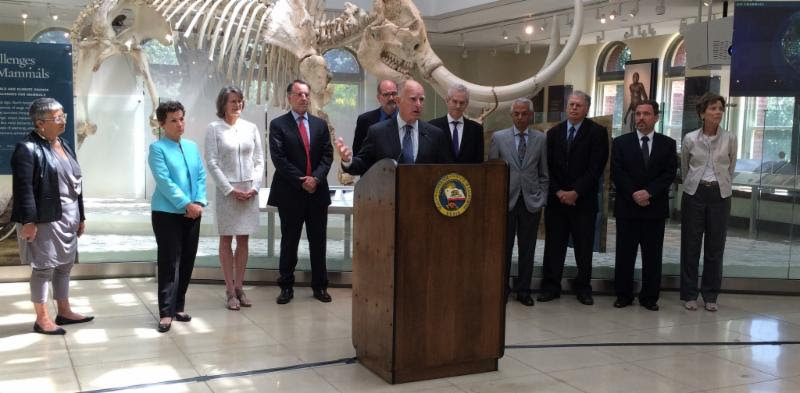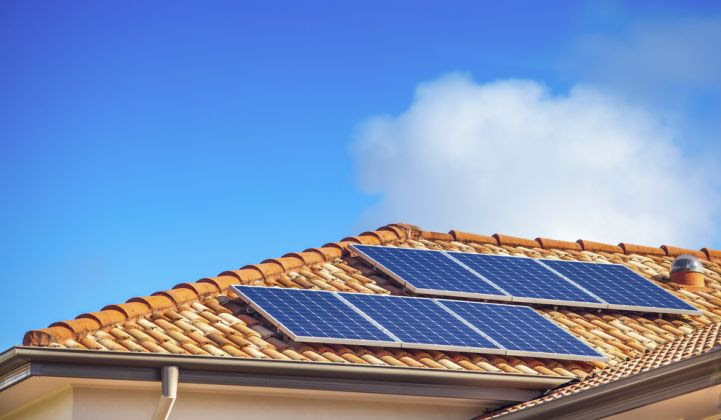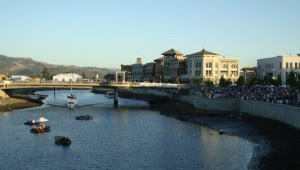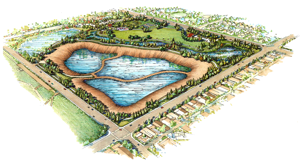The major firestorms, hurricanes and mudslides of 2017 underscored the pervasive and growing urgency to improve resilience at the community level.
Resilient Infrastructure: Sustainable Responses to a Changing Climate
These kinds of catastrophes have happened, they’ll continue to happen, and we have to be prepared to do everything we can to mitigate.
– Governor Jerry Brown, State of California

The major firestorms, hurricanes and mudslides of 2017 underscored the pervasive and growing urgency to improve resilience at the community level.
Beyond the devastating impact on people’s lives and livelihoods, these disasters ravaged infrastructure – from individual homes and businesses in affected neighborhoods to critical transportation infrastructure in cities and across the region.
The Sonoma County fires destroyed an estimated 5% of housing stock – more than 6,000 homes – in Santa Rosa.
In Santa Barbara, the recent, fast-moving mudslides shut down Highway 101, forcing residents to find alternative modes of travel. For example, two whale watching companies ran special commuter ferries between the Ventura and Santa Barbara harbors at a cost of $32 per trip. The Amtrak Pacific Surfliner operated more commuter trains along the Santa Barbara-Ventura coast, while the 101 Freeway and other major roads are closed due to storm and mudslide damage.
Hurricane Harvey, the most powerful hurricane in 50 years, hit the Texas coast last August and damaged 27% of Houston’s commercial real estate – 12,000 properties worth an estimated $55 billion.
State Leadership: New Legislation and Guidelines

In 2015, Governor Jerry Brown issued Executive Order B-30-15, requiring all state agencies to consider climate change in their planning and investment decisions. A number of bills followed – including AB 2800 and AB 1482 Gordon – that directed state agencies to consider climate risks to California’s infrastructure.
State agencies are now required to take into account the expected impacts of climate change when planning, designing, building, and investing in state infrastructure. The Strategic Growth Council must now review and comment on the State’s Five-Year Infrastructure plan to take current and future climate-change impacts into account in all infrastructure projects.
The Natural Resources Agency established a Climate-Safe Infrastructure Working Group to examine how to integrate scientific data concerning projected climate change impacts into state infrastructure engineering, and make specific recommendations to the Legislature and the Strategic Growth Council.
California also adopted a suite of laws in 2015 and 2016 that requires cities and counties to incorporate climate adaptation and resiliency strategies into their general plans’ safety elements (SB 379) and implement better coordination among state, local and regional climate adaptation efforts (SB 246).
Local Action: Models for Implementation
While state leaders are framing new legislation and policy mandates, cities are leading on-the-ground efforts to update local capital plans and ordinances that incorporate climate risks and responses.
Building Forward LA. In December 2013, the Los Angeles City Council passed a building code update that will require all new and refurbished homes to have cool roofs, which use sunlight-reflecting materials. Los Angeles is the first major city to require such a measure. Increasing cool roofs will help reduce the urban heat-island effect and help the city respond to increasing heat.
More recently, Los Angeles started a process to more comprehensively update its building codes, policies and procedures. In partnership with local and national organizations, Mayor Eric Garcetti launched “Building Forward LA,” an initiative to further LA’s efforts to update and “futurize” policies and processes that influence how city buildings are designed and constructed. Building Forward LA encourages buildings of all types to integrate advancements and innovations in design, engineering and construction, and take full advantage of our buildings’ ability to improve the environment.
Boston’s Climate Change Preparedness and Resiliency Checklist. The City of Boston requires all projects subject to a specific portion of the City’s zoning code to complete a Climate Change Preparedness and Resiliency Checklist (2015) as part of the project review process.
San Francisco’s Office of Resilience and Capital Planning (ORCP). Part of the City Administrator’s office, ORCP oversees policies, interagency initiatives and financial strategies that support the “integrity and resilience of the City’s infrastructure and the people who rely on it.” Its resources include Guidance for Incorporating Sea Level Rise into Capital Planning, which provides capital-planning direction to all departments on how to incorporate sea-level rise impacts into new construction, capital improvement and maintenance projects. For more info
Climate Resiliency Design Guidelines in New York City. Mayor Bill de Blasio announced the release of preliminary Climate Resiliency Design Guidelines in April 2017, which for the first time establish citywide guidance on incorporating projected climate-change impacts throughout its capital program – the largest in the country – including planning, engineering, construction and renovation of City facilities.
Community Programs: Principles and Practices for More Resilience
Communities are also implementing projects that increase the resiliency of local infrastructure, ranging from houses and businesses to municipal water infrastructure. These initiatives take a variety of approaches:
Increase the resiliency of buildings to handle higher temperatures
Lancaster Zero Net Energy: The City of Lancaster plans to use plentiful solar energy and increasing heat to drive economic development with a vision of becoming one of the first net-zero cities in the world.
“The first thing we did is convert all the City buildings to solar: 97% of all the City power for City-owned buildings comes from the sun,” said Mayor Rex Parris. “We now have 32,000 solar panels at our schools. We have 2,000 homes with permits for solar. Next year, every kilowatt used in Lancaster will be replaced by the sun.”
Lancaster’s building codes now require that all new single-family homes must include a 1.0 kilowatt solar system, and they’ve also improved the permit process so that residents can now obtain a permit to add solar on an existing house over the counter.

Increase the resiliency of commercial infrastructure
Sacramento Region Business Continuity Initiative: An estimated 25% of small to mid-sized businesses don’t reopen following a major disaster, according to the Institute for Business and Home Safety. A report by the American Sustainable Business Council found that the majority of small businesses have not closely analyzed the potential economic losses from extreme weather events or other climate-related risks. Moreover, 57% of small businesses don’t have a disaster recovery plan.
Valley Vision conducted a regional effort to increase awareness of and preparedness for business-continuity risks faced by small and medium-sized enterprises in California’s Capital Region. The initiative helps the business community prepare to withstand the economic consequences that could result from an unexpected disruption in operations. They created a toolkit that identifies concise, action-oriented steps that will help small businesses become more resilient before the crisis hits, helping to create a community that’s better prepared to weather any storm.
Collaborate on regional strategies to address rising seas
In 2016, Bay Area voters approved Measure AA, which included a new $12-per-parcel tax that will raise $500 million for bay enhancement and habitat restoration project that increase the region’s resilience to sea-level rise.
Resilient By Design Bay Area Challenge: The Bay Area has also launched a year-long collaborative design challenge bringing together local residents, public officials and design teams made up of local and international architects, engineers, ecologists and other experts to develop 10 innovative community-based solutions to strengthen the region’s resilience to sea-level rise, severe storms, flooding and earthquakes.
Take “living river” measures to minimize flood risks

Napa River‐Napa Creek Flood Protection Project: The Napa River has seen 22 serious floods since 1862. After two hard-infrastructure approaches were rejected by voters, a community coalition of businesses, environmentalists, residents and stakeholder agencies designed a “living river” approach, which envisioned reconnecting the river to its historic flood plain, maintaining the river’s natural slope and width and other natural features (mud flats, shallows and sandbars), and supporting a continuous fish-and-riparian corridor along the river. This environmental restoration included creating and reinvigorating wetlands.
This strategy was ultimately approved through Measure A by a two-thirds majority of voters. In addition to environmental restoration, the project also increased public and private investment ($898 million from 1997-2010) and revitalization along the riverfront while reducing flood risk.
Increase water resiliency through green infrastructure
Green Infrastructure in Los Angeles: Los Angeles has created a number of low-impact development models using bonds and reallocating funds from hard-infrastructure projects to pay for green-infrastructure projects that achieve water conservation, improve water quality, provide flood protection, and meet stormwater-management objectives.

In 2004, Los Angeles voters overwhelmingly passed Proposition O, which authorized $500 million in bonds for water conservation, water quality, flood-protection and stormwater-management projects. They also passed a low-impact development ordinance in 2012 to ensure that development and redevelopment projects mitigate runoff using natural resources and capturing rainwater at its source.
This commitment has resulted in large-scale initiatives, such as the Sun Valley Watershed project, that integrate flood control, stormwater-pollution reduction and water-conservation efforts through infiltration and stormwater recycling practices.
Changing Infrastructure to Create New Opportunities
The impacts of climate change are not going away anytime soon – and doing nothing isn’t really an option. The good news is that there is a wide array of practical strategies available at the local, regional and state levels to help mitigate the consequences for our environment and our economy.
As these model projects and forward-thinking legislation demonstrate, we already have the capacity – in innovative tools, vision and political will – to adapt our communities to make them more resilient. In many instances, we can take these climate-smart steps in ways that also strengthen the public health, economic vitality and social prosperity of the places where we live, work and raise our families – for generations to come.
Working together, resilient infrastructure represents a promising human opportunity to create our community’s future – and go beyond the environmental horizon of a changing climate.

Resources
“Built to Last: Challenges and Opportunities for Climate-Smart Infrastructure in California” (Jamesine Rogers Gibson, Union of Concerned Scientists, November 2017)
Local Government Commission Newsletters
Livable Places Update
CURRENTS Newsletter
CivicSpark™ Newsletter
LGC Newsletters
Keep up to date with LGC’s newsletters!
Livable Places Update – April
April’s article: Microtransit: Right-Sizing Transportation to Improve Community Mobility
Currents: Spring 2019
Currents provides readers with current information on energy issues affecting local governments in California.
CivicSpark Newsletter – March
This monthly CivicSpark newsletter features updates on CivicSpark projects and highlights.



